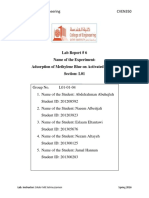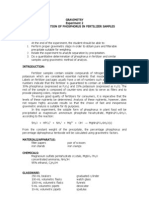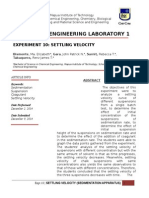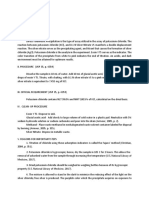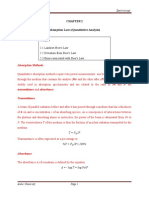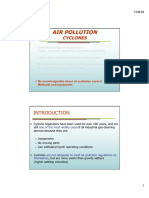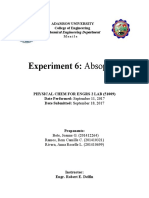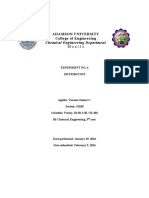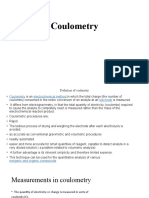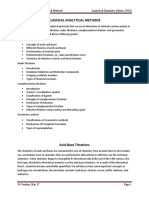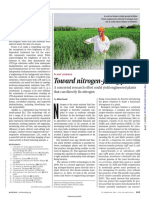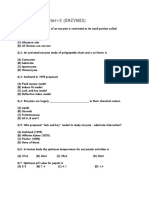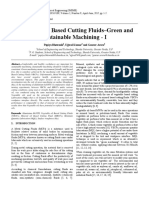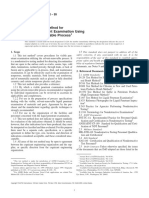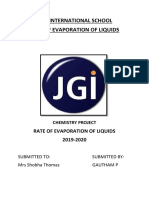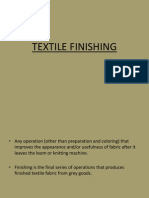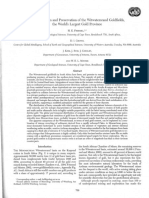Experiment 5
Experiment 5
Uploaded by
Kathleen BartoloCopyright:
Available Formats
Experiment 5
Experiment 5
Uploaded by
Kathleen BartoloOriginal Description:
Copyright
Available Formats
Share this document
Did you find this document useful?
Is this content inappropriate?
Copyright:
Available Formats
Experiment 5
Experiment 5
Uploaded by
Kathleen BartoloCopyright:
Available Formats
Experiment 5
REFRACTIVE INDEX OF LIQUIDS AND SOLUTIONS
Johanna C. Alvarez, Kathleen T. Bartolo, Krista C. Batac,
Daniel E. Belando, and Rinnel L. Bonifacio
Group 1 2C Biochemistry Physical Chemistry Laboratory
ABSTRACT
The refractive index of different liquid solutions was determined in this experiment using the
abbe refractometer. The specific and molecular refractivity of each liquid were also determined.
drops of solution were put in the prism, after it was cleaned and calibrated using water. The
correct adjustment of the refractometer was done, that is, the demarcation line between light
and dark fields seen through the eyepiece is distinct and intersects the cross hairs. The readings
of the index of refraction were recorded. In determining the density of the liquids, we used
Westphal balance. Specific refraction and molecular refraction were calculated using the
refractive index and density, and average molecular weight. In this experiment, the relationships
between identities of solution were concluded, that the refractive index of a medium is inversely
proportional to the velocity of light in a medium. Therefore, light travels faster in water.
INTRODUCTION
Refractive index of pure liquid that is measured and displayed on the
substances and of their solutions is an optical monitor of the refractometer, in which it
property of matter that has been measured shows the objectives of this experiment: (1)
and interpreted since the early nineteenth To measure refractive indices of a liquids
century,[1] Refractive index is used in many using Abbe Refractometer; and (2) to
fields such as food production, determine the relationship between
pharmaceuticals and other chemical based concentration and refractive index.
industry to monitor the purity of a substance
that also serves as an important optical
parameter, since some refractive index data EXPERIMENTAL
for some liquids cannot be easily found in A. Sample used
reference books, it must be measured if
needed in some cases,[2]. To address the Castor oil, 0.1 Sucrose Solution, and
interrelationship between the refractive index Distilled water was used in this experiment to
and the density of pure liquids and of their demonstrate refractive index of liquid, and to
ideal mixtures, there are obtained equations measure concentration dependence of
describing the dependence on composition of refractive index
the ideal refractive index. Thereafter, the
refractive index increases upon the operation B. Procedure
of mixing two liquids to form an ideal mixture
and with changing composition at fixed To determine the refractive index of
temperature, it demonstrates theoretically liquid using abbe refractometer, we are to
that the squared ideal refractive index operate the Abbe refractometer, to clean the
depends linearly on both the ideal density and prisms lint-free tissue paper is to be used,
the reciprocal of ideal molar volume.[3] then with a 3-5 drops of liquid sample on the
surface of the lower prism, observe trough the
In this experiment, Abbe ocular and adjust the knobs clockwise or
Refractometer was used, which is one of the counter-clockwise till the boundary of the
most common instruments that is used to light and dark half on the boundary becomes
measure refractive indices of a substance. To tangent with intersections of crossed hairs.
determine refractive index a knob is adjusted Use the Westphal balance to determine the
until the dark half of the view until it reaches density of the substances and repeat the
the two intersection of two lines of the view, procedure for 3 trials for different substance.
Computations used:
Calculating the Specific Refraction and Molar
Refraction
Rs= [(n2 –1) / (n2+ 2)] 1/ρ
Rm= Rs (M ave)
where: n= refractive index
ρ= density
M ave = Average Molecular weight
Rs = specific refraction
Rm = molecular refraction
Table 1. Refractive index of liquid.
RESULTS AND DISCUSSION
Sample dH2O Castor Oil 0.01
In order to understand and explain the
Sucrose
use of refractive index and be able to
Molecula 18.01 1933.402 342.296
determine the relationship of concentration
r Weight g/mol g/mol g/mol
and, refractive index we use different liquid
Density 1.00g/m 0.961g/m 2.98g/m
sample with different density and molecular
L L L
weight. To determine the quantitative
measure of refractive index, is to compute
Refractiv 16.0 18.0 17.8
with the velocity of light c of a given
e index.
wavelength in empty space divided by its
Trial 1
velocity v in a substance, or n = c/v, and to
Trial 2 16.9 17.9 17.9
multiple mole fraction from refractive index,
Multiply the mole fraction of each component Trial 3 16.5 18.0 17.3
by the refractive index of that component, Mean 16.5 18.0 17.3
then sum all products to determine the Standard 0.260 0.00882 0.2400
estimated refractive index of the solution. The Error
experiment was assumed to have a room
temperature of 25°C and an atmospheric
pressure of 1 atm with a 10 dm light bulb.
In table 1, three trials are done to
The refractive index of a medium is inversely compare 3 liquid samples (distilled water,
proportional to the velocity of light in a caster oil, and 0.01M sucrose solution)
medium. Therefore, light travels faster in
water. Refractive index measures the The obtained mean of refractive index for the
concentration of solute in a solution and can trials are 16.5, 18.0, and 17.3 with the
also be used to identify a substance or confirm density of 1.00g/mL, 0.961g/mL, 2.98g/mL
its purity by measuring the concentration, respectively. The data obtained, shows an
knowing that the refractive index could give
inverse relationship for the density and
some information about molecular structure
refractive index, as it shows that Castor oil
of compounds, determine the sugar content
of solutions and identify the identity of a has higher refractive index and has the lowest
sample by relating or comparing the known density compared to the other substance,
values to refractive index. Specific refractivity same with the rest of the samples.
and molecular refractivity, which has been
determined in this experiment, and would
also be more useful in determining the
variation of a solution in order to know its
contents by comparing it to the true value.
Table 2. Concentration Dependence on
Refractive Index.
Conc. 1% 3% 5% 10%
(Glycerol)
Density 3.00 3.0 3.0 3.09
g/ml 00 580 790 00
Refractive 17.0 17. 17. 17.5
Index 2 3
Molar 30.3 29. 29. 29.5
Refractivit 8 81 61 1
y
(cm3/mol)
In Table 2, it shows the relationship of
density, refractive index, and Molar
refractivity where, we know that the molar
refractivity is a measure of the total
polarizability of a mole of a substance and is
dependent on the temperature. The
relationship between the index of refraction is
directly proportional with density, whereas,
the refraction index increases as the density
of a solution increases, and we can also see
that when the refractive index increases the
concentrated glycerol also increases.
Moreover, the specific and molecular
refraction also increases with increase in
mole.
REFERENCES
[1] J. R. Partington, An Advanced Treatise on
Physical Chemistry, Vol. 4, Physico-
Chemical Optics, Longmans, London,
1953.
[2] H.B. Thomas, K. Matsumoto, T. Eiju, K.
Matsuda, N. Ooyama, Appl. Opt. 30, 745
(1991).
[3] A. F. S. Santos, M. L. C. J. Moita, I. M. S.
Lampreia, J. Chem. Thermodyn. 2009,
41, 1387 – 1393. Note: Redlich–Kister ai
coefficients in Table 2 of this reference
are valid for aqueous mixtures with x(1-
PP-2-ol)0.041 and the bi coefficients are
for x(1-PP-2-ol)0.041
You might also like
- Thin Layer Chromatography Lab Report Experiment 04Document5 pagesThin Layer Chromatography Lab Report Experiment 04PDPPPMAT0621 Ruhilin Binti NasserNo ratings yet
- Density Determination by PycnometerDocument15 pagesDensity Determination by PycnometerNill Patrick Ulat DulceNo ratings yet
- Distribution CoefficientDocument23 pagesDistribution CoefficientJim100% (1)
- Determination of Copper Concentration Using UV Vis SpectrophotometeryDocument6 pagesDetermination of Copper Concentration Using UV Vis SpectrophotometeryLoeyNo ratings yet
- Lab Report # 6 Name of The Experiment: Adsorption of Methylene Blue On Activated Carbon Section: L01Document8 pagesLab Report # 6 Name of The Experiment: Adsorption of Methylene Blue On Activated Carbon Section: L01islamNo ratings yet
- Formal Lab ReportDocument4 pagesFormal Lab ReportBren SisonNo ratings yet
- Lab Report Beer S LawDocument16 pagesLab Report Beer S LawRhema Mohabul100% (3)
- Experiment No. 1 CpiDocument24 pagesExperiment No. 1 CpiIan KoNo ratings yet
- Experiment 6 PhosphorusDocument4 pagesExperiment 6 PhosphorusMia Domini Juan Loa100% (2)
- Adsorption Lab ManualDocument6 pagesAdsorption Lab ManualSatyamGupta0% (1)
- Problema 1Document2 pagesProblema 1PepeAranda0% (1)
- Hydrodynamic VoltammetryDocument2 pagesHydrodynamic VoltammetrySean Collins67% (3)
- Determination of Intrinsic Viscosity and MW OF PolystyreneDocument19 pagesDetermination of Intrinsic Viscosity and MW OF PolystyreneNouran ShedidNo ratings yet
- Determination of S As Barium SulfateDocument7 pagesDetermination of S As Barium SulfateRon AguilarNo ratings yet
- Determination of Chloride by Volhard and Mohr MethodDocument6 pagesDetermination of Chloride by Volhard and Mohr MethodShane AmolarNo ratings yet
- Final Report Expt10 (CHELAB1)Document8 pagesFinal Report Expt10 (CHELAB1)PatrickGara100% (1)
- Chapter 1 Lab ReportDocument5 pagesChapter 1 Lab ReportJabin Sta. TeresaNo ratings yet
- Chem2 Ch13 Skoog Lab Volumetric Analysis TitrationDocument40 pagesChem2 Ch13 Skoog Lab Volumetric Analysis TitrationBochibo Snatch100% (1)
- CRE Lab ManualDocument19 pagesCRE Lab ManualMayursinh Solanki100% (1)
- EXPERIMENT NO 2 Separation of An Organic Mixture, Re Crystallization and Melting Point DeterminationDocument7 pagesEXPERIMENT NO 2 Separation of An Organic Mixture, Re Crystallization and Melting Point DeterminationJanina NemisNo ratings yet
- Experiment No. 5 - Precipitation (KCL)Document3 pagesExperiment No. 5 - Precipitation (KCL)Katherine A. PerezNo ratings yet
- Instrumental Analytical Methods Experiment 1 - Flame-Photometric AnalysisDocument3 pagesInstrumental Analytical Methods Experiment 1 - Flame-Photometric Analysisapi-23518718950% (2)
- Chem 3052 CHAPTER 2 (Absorption Law)Document8 pagesChem 3052 CHAPTER 2 (Absorption Law)ashenafi100% (1)
- 4-Cyclones HandoutDocument18 pages4-Cyclones HandoutfatimaNo ratings yet
- TLC Separation of Amino AcidsDocument5 pagesTLC Separation of Amino Acidshmtlion0% (5)
- Experiment 6 Lab ReportDocument21 pagesExperiment 6 Lab ReportmarkkkkkNo ratings yet
- My Final Report On Viscosity of A LiquidDocument8 pagesMy Final Report On Viscosity of A LiquidKuo Sarong100% (1)
- Instrumental Analysis IIDocument3 pagesInstrumental Analysis IIashenafi100% (3)
- Precipitation Titration 1Document25 pagesPrecipitation Titration 1Beyond LbbNo ratings yet
- Spectrophotometric Determination of TheDocument3 pagesSpectrophotometric Determination of TheAat SholihatNo ratings yet
- The Rydberg Constant: ExperimentDocument10 pagesThe Rydberg Constant: ExperimentBhure ParshuramNo ratings yet
- Chemical Equilibrium in A Liquid PhaseDocument7 pagesChemical Equilibrium in A Liquid PhasePevie Anne Tenebroso100% (2)
- Precipitation TitrationDocument3 pagesPrecipitation TitrationBanana SenpaiNo ratings yet
- Solid Fuels W:oDocument3 pagesSolid Fuels W:oShane PatulotNo ratings yet
- Experiment 4 - DistributionDocument14 pagesExperiment 4 - DistributionVanessa Denise Aguilar92% (12)
- External Calibration MethodDocument10 pagesExternal Calibration Methodvanessa olgaNo ratings yet
- Volumetric AnalysisDocument66 pagesVolumetric AnalysisAvan100% (1)
- CoulometryDocument20 pagesCoulometryCbn Noon100% (1)
- Standardizing A Solution of Sodium Hydroxide Revised PDFDocument6 pagesStandardizing A Solution of Sodium Hydroxide Revised PDFAlexya RosasNo ratings yet
- Lab ReportDocument10 pagesLab ReportKathleen De Vera Barril100% (1)
- Reaction Rate and Rate Constant of The Hydrolysis of Ethyl Acetate With Sodium HydroxideDocument5 pagesReaction Rate and Rate Constant of The Hydrolysis of Ethyl Acetate With Sodium HydroxideAmyNo ratings yet
- Lab Report Basic Organic Chemistry CHM20Document3 pagesLab Report Basic Organic Chemistry CHM20Muhd Mirza Hizami100% (1)
- Instrumental Analysis II Lab ManualDocument38 pagesInstrumental Analysis II Lab Manualhagos abdu100% (3)
- Radiation Heat Transfer ExperimentDocument6 pagesRadiation Heat Transfer ExperimentDaniel IsmailNo ratings yet
- Momentum TransportDocument127 pagesMomentum TransportHarry100% (2)
- Labrep Experiment 6 - ViscosityDocument4 pagesLabrep Experiment 6 - ViscosityArianne BatallonesNo ratings yet
- Surface TensionDocument6 pagesSurface TensionKojo EghanNo ratings yet
- 1st Long ExamDocument2 pages1st Long ExamJoshua DimaanoNo ratings yet
- Worksheet 4 Combustion of Gas and Liquid FuelDocument3 pagesWorksheet 4 Combustion of Gas and Liquid FuelLin Xian XingNo ratings yet
- CHAPTER 1 - LEACHING Continuous CountercurrentDocument15 pagesCHAPTER 1 - LEACHING Continuous Countercurrentsimple_uu100% (2)
- 3-Classical Analytical MethodsDocument35 pages3-Classical Analytical MethodsAlice MakeNo ratings yet
- Laboratory Plan 1:: Standardization of Sodium Hydroxide (Naoh) With Potassium Hydrogen Phthalate (KHP)Document4 pagesLaboratory Plan 1:: Standardization of Sodium Hydroxide (Naoh) With Potassium Hydrogen Phthalate (KHP)Alliza Kaye CasullaNo ratings yet
- Flame PhotometerDocument2 pagesFlame PhotometerDebleena ChakrabortyNo ratings yet
- Objective: The Objective of This Laboratory Is: - To Standardise of A Hydrochloric Acid (HCL) SolutionDocument12 pagesObjective: The Objective of This Laboratory Is: - To Standardise of A Hydrochloric Acid (HCL) SolutionShaker HusienNo ratings yet
- Problems and Solutions: Physical ChemistryDocument179 pagesProblems and Solutions: Physical ChemistryRialeeNo ratings yet
- Standard SolutionDocument5 pagesStandard SolutionAmmar Ahmed Malik 834-FBAS/MSES/S20100% (1)
- Chapter 13Document16 pagesChapter 13Banana QNo ratings yet
- Lab Report Exp 1Document15 pagesLab Report Exp 1Justine Camille CastilloNo ratings yet
- التجربة الثانية الانكسارDocument3 pagesالتجربة الثانية الانكسارAymen AbdulrahmanNo ratings yet
- Nitrogen FixationDocument3 pagesNitrogen Fixationchama_gozNo ratings yet
- Separation & Identification of GROUP II CationsDocument12 pagesSeparation & Identification of GROUP II CationsxbillupsNo ratings yet
- A1 Form PDFDocument8 pagesA1 Form PDFAsim AqeelNo ratings yet
- Engineering Chemistry - (Malestrom)Document602 pagesEngineering Chemistry - (Malestrom)Sandeep Kotagiri75% (8)
- Beat The HeatDocument6 pagesBeat The HeatGuido GalfanoNo ratings yet
- The Beam Measurements at PHIN Photo-Injector at CERN: RF Photo Gun LaserDocument1 pageThe Beam Measurements at PHIN Photo-Injector at CERN: RF Photo Gun LaserMustafa AlzzerfiNo ratings yet
- The Design ColummDocument8 pagesThe Design ColummWalter Ruiz AstoNo ratings yet
- Mudmat Role in Offshore Drilling Operations: August 2015Document4 pagesMudmat Role in Offshore Drilling Operations: August 2015Dr R Panneer SelvamNo ratings yet
- MCQ TEST Chapter 3 (ENZYMES)Document14 pagesMCQ TEST Chapter 3 (ENZYMES)Ali HyderNo ratings yet
- 08jul201510072420 Papiya Bhowmik 1-5Document5 pages08jul201510072420 Papiya Bhowmik 1-5tkas4uNo ratings yet
- Formulating Liquid Laundry Detergents: Technical ArticleDocument4 pagesFormulating Liquid Laundry Detergents: Technical ArticleramzibtrNo ratings yet
- MGPS MA L01 QuizDocument3 pagesMGPS MA L01 QuizsalmaabutabaqNo ratings yet
- Thermo Fluids 10.3.19Document68 pagesThermo Fluids 10.3.19norsiahNo ratings yet
- SWP-22 Lock Out Tag Out DaimanDocument2 pagesSWP-22 Lock Out Tag Out DaimanHassan AbdullahNo ratings yet
- Expediting Report MIL-18AugDocument3 pagesExpediting Report MIL-18AugjasmineammaNo ratings yet
- Lab Tests On Permanent Materials Used in Construction and Its Reference With BSDocument7 pagesLab Tests On Permanent Materials Used in Construction and Its Reference With BSSandeep Pillai100% (1)
- Visible Penetrant Examination Using Solvent-Removable ProcessDocument6 pagesVisible Penetrant Examination Using Solvent-Removable ProcessERNESTO ENRIQUE FERNANDEZ BAPTISTANo ratings yet
- Solutions - DPP 08 (Of Lec 09) - Lakshya JEE 2024Document3 pagesSolutions - DPP 08 (Of Lec 09) - Lakshya JEE 2024Hamza KhanNo ratings yet
- Enhancement of Microwave Absorption Using Frequency Selective Surface With Electronic WasteDocument37 pagesEnhancement of Microwave Absorption Using Frequency Selective Surface With Electronic WasteVivekNo ratings yet
- 2022, Eur J Org Chem - 2022 - GeorgeDocument5 pages2022, Eur J Org Chem - 2022 - GeorgeAbhishek PareekNo ratings yet
- LTB-26 Lubricant Storage, Stability and Shelf Life 120120Document3 pagesLTB-26 Lubricant Storage, Stability and Shelf Life 120120Jorge Flores BarzolaNo ratings yet
- Jain International School Rate of Evaporation of LiquidsDocument14 pagesJain International School Rate of Evaporation of LiquidsGAUNo ratings yet
- OsteoporosisDocument13 pagesOsteoporosisMimi Suhaini SudinNo ratings yet
- Winter-Break Assignment Class 8Document5 pagesWinter-Break Assignment Class 8anupamNo ratings yet
- PEMEDocument1 pagePEMERajesh MohananNo ratings yet
- Textile FinishingDocument61 pagesTextile Finishingsalonivora95% (22)
- 2005 The Formation and Preservation of The WitwatersrandDocument29 pages2005 The Formation and Preservation of The WitwatersrandMariluz Castro SernaNo ratings yet
- How Does Penicillin WorkDocument6 pagesHow Does Penicillin WorkJanista FrankNo ratings yet
- MEP CompanyDocument24 pagesMEP Companyniteen_mnnitNo ratings yet
- Research PaperDocument26 pagesResearch PaperChristine Gail Pales100% (2)




